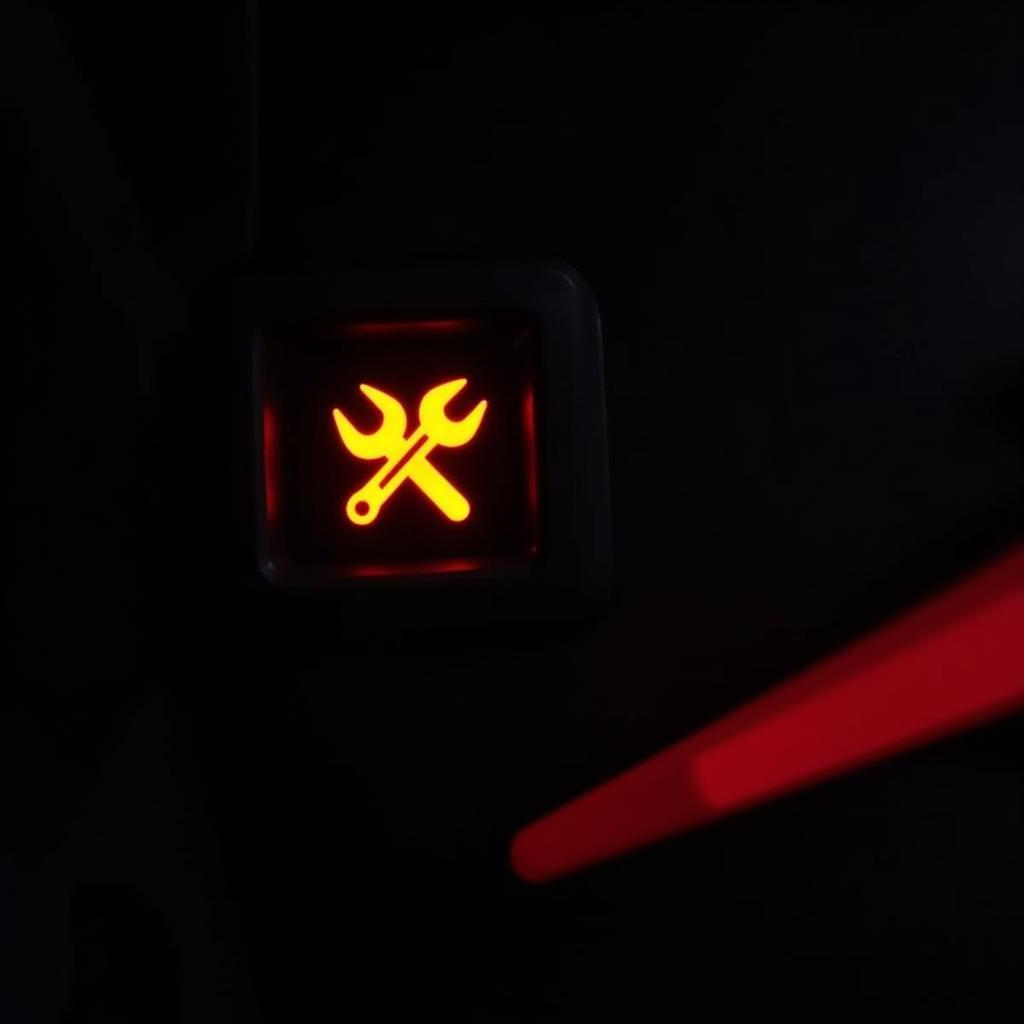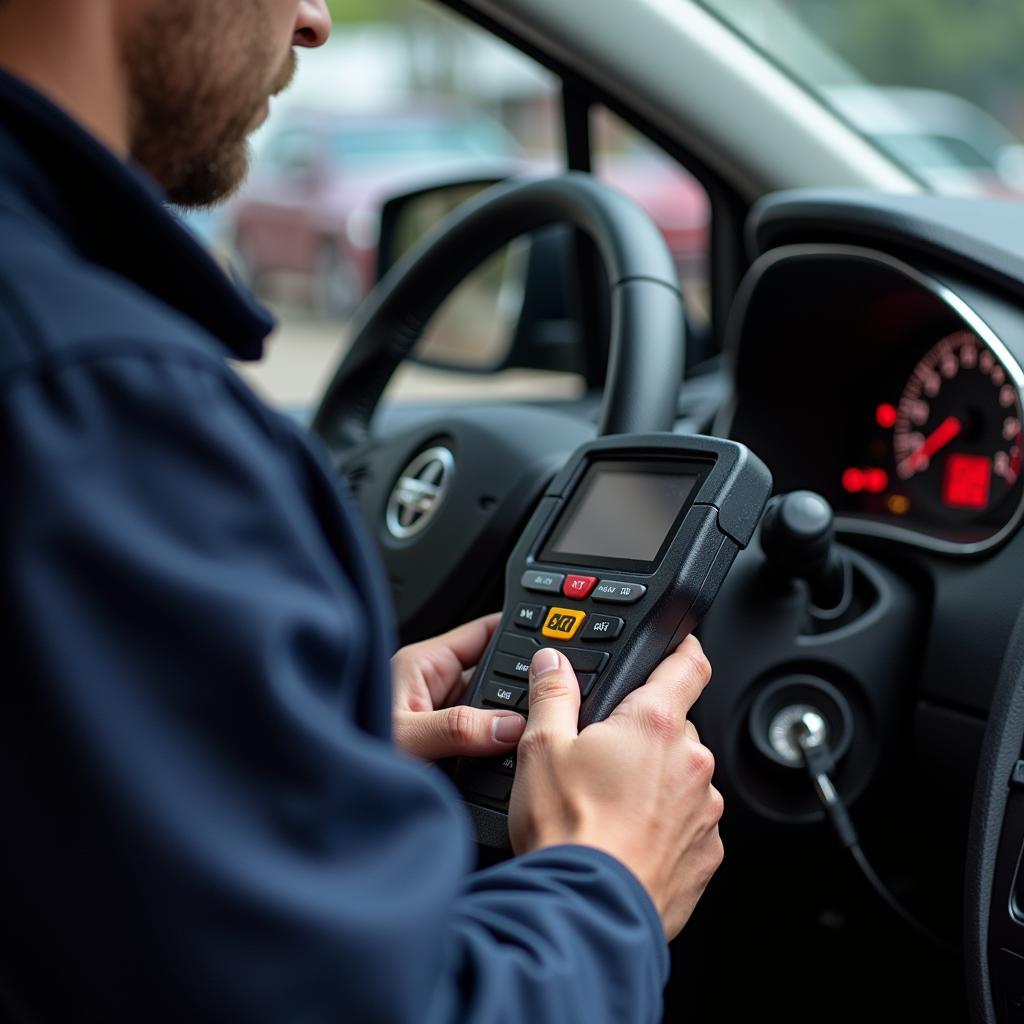A parking brake with wrench warning light illuminating on your dashboard can be a cause for concern. While it might seem daunting at first, understanding the potential causes and solutions can save you time, money, and unnecessary worry. This comprehensive guide will walk you through everything you need to know about this common issue, from diagnosis to resolution.
Decoding the Warning: What Does It Mean?
The parking brake with wrench warning light typically indicates a fault within the parking brake system or a related electronic component. This could range from a simple issue like a disengaged parking brake switch to a more complex problem with the electronic parking brake module.
Common Causes of the Parking Brake with Wrench Warning Light
Several factors can trigger this warning light, and understanding the common culprits can help you narrow down the source of the problem:
- Engaged Parking Brake: The most obvious reason is an engaged parking brake. Before panicking, ensure the parking brake is fully released.
- Faulty Parking Brake Switch: The switch that detects whether the parking brake is engaged or disengaged can malfunction, sending a false signal to the car’s computer.
- Worn Brake Pads: While not directly related to the parking brake, worn brake pads can sometimes trigger the wrench warning light as a general brake system alert.
- Low Brake Fluid: Similar to worn brake pads, low brake fluid levels indicate a potential issue with the braking system, potentially triggering the warning light.
- Electronic Parking Brake Module Malfunction: Modern vehicles with electronic parking brakes rely on a control module. If this module experiences issues, it can lead to the warning light appearing.
- Wiring Problems: Damaged or corroded wiring within the parking brake system can disrupt communication, causing the warning light to illuminate.
Diagnosing the Problem: Steps to Take
Identifying the specific cause of the warning light is crucial for effective repair. Here’s a step-by-step guide:
- Check the Obvious: Ensure the parking brake is fully disengaged. Sometimes, the simplest solution is the right one.
- Inspect Brake Fluid: Locate the brake fluid reservoir and check the fluid level. If it’s low, add the recommended brake fluid type for your vehicle.
- Visual Inspection: Look for any visible signs of damage or wear in the parking brake mechanism, wiring, and connections.
- Consult a Mechanic: If the above steps don’t pinpoint the issue, it’s best to consult a qualified mechanic with diagnostic tools. They can accurately diagnose the problem using a scanner to read error codes from the vehicle’s computer.
 Dashboard Warning Light
Dashboard Warning Light
Resolving the Issue: Repair Options
Depending on the diagnosis, resolving the parking brake with wrench warning light can involve:
- Simple Fixes: If the issue is a disengaged switch or low brake fluid, the solution is straightforward. Replacing the faulty switch or topping off the brake fluid can resolve the problem.
- Brake Pad Replacement: If worn brake pads are detected, replacing them is crucial for optimal braking performance and safety.
- Module Replacement or Repair: If the electronic parking brake module is faulty, it may require replacement or repair. This is typically a more complex procedure best handled by a qualified mechanic.
- Wiring Repair: Damaged or corroded wiring needs to be repaired or replaced to restore proper communication within the system.
Importance of Prompt Action
Ignoring the parking brake with wrench warning light can lead to:
- Safety Hazards: A malfunctioning parking brake system poses safety risks, especially when parked on inclines.
- Further Damage: Delaying repairs can exacerbate the underlying issue, leading to more extensive and costly damage to the braking system.
- Inconvenience: A persistent warning light can be a nuisance, potentially affecting the vehicle’s performance and drivability.
 Mechanic Diagnosing Brake Problem
Mechanic Diagnosing Brake Problem
Preventing Future Issues: Maintenance Tips
- Regular Brake Inspections: Schedule routine brake inspections as part of your vehicle maintenance to detect and address potential issues early on.
- Parking Brake Usage: Engage the parking brake regularly, even when parked on flat surfaces. This helps prevent the mechanism from seizing.
- Quality Parts: When repairs are needed, opt for high-quality replacement parts to ensure longevity and reliable performance.
- Professional Service: Choose a reputable mechanic specializing in automotive diagnostics and repair for accurate diagnosis and quality service.
Frequently Asked Questions
Q: Can I drive with the parking brake with wrench warning light on?
A: While it’s possible to drive short distances, it’s not recommended. The warning light indicates a potential issue with your braking system, which could compromise safety.
Q: How much does it cost to fix a parking brake with wrench warning light?
A: The cost varies depending on the underlying cause. Simple fixes like a switch replacement might be relatively inexpensive, while module replacements can be more costly.
Q: Is it safe to ignore the warning light if my parking brake seems to be working fine?
A: No, ignoring the warning light is not advisable. Even if the parking brake seems operational, an underlying issue might worsen and lead to more severe problems.
Q: Can a low car battery trigger the parking brake with wrench warning light?
A: While rare, a low battery can sometimes cause erratic behavior in electronic systems. It’s best to rule out other potential causes first.
Q: How often should I have my brake system inspected?
A: It’s generally recommended to have your brake system inspected at least once a year or every 12,000 miles, or as recommended in your vehicle’s owner’s manual.
Conclusion
The parking brake with wrench warning light signals a potential issue with your vehicle’s braking system. Addressing the problem promptly through proper diagnosis and repair is crucial for ensuring safety and preventing further damage. By understanding the common causes, following the recommended diagnostic steps, and seeking professional assistance when needed, you can confidently address this issue and get back on the road safely.
